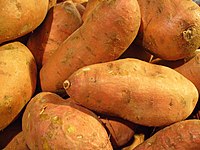
Photo from wikipedia
In recent years, there has been increasing interest in the functional components of sweet potato because of its nutritional and medicinal value. The aim of this study is to analyse… Click to show full abstract
In recent years, there has been increasing interest in the functional components of sweet potato because of its nutritional and medicinal value. The aim of this study is to analyse how much sweet potato phenolic compounds composition (derived from caffeoylquinic acids) varies as a result of cooking. Traditional techniques such as: boiling, oven roasting and more recent processing techniques such as microwave cooking were tested. Three sweet potato varieties were cooked for different periods of time and under different conditions. Ultrasound-assisted extraction (UAE) was used to extract the compounds of interest and then, a chemometric tool such as Box-Behnken design (BBD) was successfully used to evaluate and optimise the most influential factors in the extraction, i.e., temperature, solvent composition and sample-to-solvent ratio. The optimal settings for UAE were: solvent 100% methanol, a temperature of 39.4 °C and a mass/volume ratio of 0.5 g per 10 mL solvent. Oven roasting of sweet potatoes resulted in increased levels of caffeoylquinic acids, whereas prolonged cooking times in water resulted in decreasing levels of the same.
Journal Title: Agronomy
Year Published: 2021
Link to full text (if available)
Share on Social Media: Sign Up to like & get
recommendations!